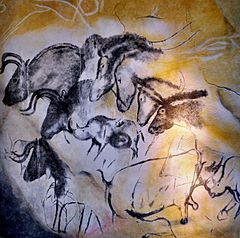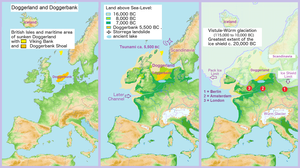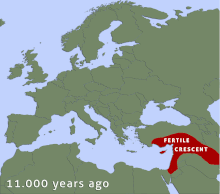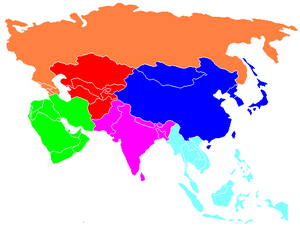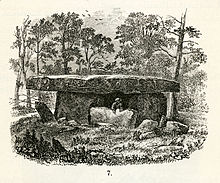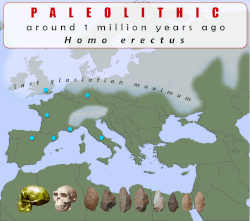
humans emerge in Europe
| |
| Early Prehistory | |
|---|---|
| Lower Paleolithic | Homo antecessor Homo heidelbergensis |
| Middle Paleolithic | Homo neanderthalensis |
| Upper Paleolithic | Homo neanderthalensis, Homo sapiens |
| Mesolithic | Homo sapiens population of all regions |
| Neolithic | Homo sapiens Proto-farmers, herding, pottery |
| Late Prehistory | |
| Chalcolithic | Indo-Europeans, agriculture, |
| Bronze Age | Minoan Crete, Mycenaean Greece |
| Iron Age | Greece, Rome Iberians, Germanic tribes |
Prehistoric Europe is the designation for the period of human presence in Europe before the start of recorded history, beginning in the Lower Paleolithic.
As history progresses, considerable regional irregularities of cultural
development emerge and increase. The region of the eastern
Mediterranean is, due to its geographic proximity, greatly influenced
and inspired by the classical Middle Eastern civilizations, and adopts
and develops the earliest systems of communal organization and writing. The Histories
of Herodotus (from around 440 BC) is the oldest known European text
that seeks to systematically record traditions, public affairs and
notable events.
In contrast, the European regions furthest away from the ancient
centers of civilization tended to be the slowest, regarding
acculturation. In Northern and Eastern Europe in particular, writing and systematic recording was only introduced in the context of Christianization, after 1000 CE.
Overview
Widely dispersed, isolated finds of individual fossils of bone fragments (Atapuerca, Mauer mandible), stone artifacts or assemblages that suggest Lower Paleolithic palaeo-human presence are rare and typically separated by thousands of years. The karstic region of the Atapuerca Mountains
in Spain represents the currently earliest known and reliably dated
location of residence for more than a single generation and a group of
individuals. Prolonged presence has been attested for Homo antecessor (or Homo erectus antecessor, Homo heidelbergensis and Neanderthals.
Homo neanderthalensis emerged in Eurasia
between 350,000 and 600,000 years ago as the earliest body of European
people, that left behind a substantial tradition, a set of evaluable
historic data through rich fossil record in Europe's limestone caves and
a patchwork of occupation sites over large areas, including Mousterian cultural assemblages. Modern humans arrived in Mediterranean Europe during the Upper Paleolithic
between 45,000 and 43,000 years ago, and both species occupied a common
habitat for several thousand years. Research has so far produced no
universally accepted conclusive explanation as to what caused the
Neanderthal's extinction between 40,000 and 28,000 years ago.
Homo sapiens subsequently proceeded to populate the entire continent during the Mesolithic and advanced north, following the retreating ice sheets of the last glacial maximum.
A 2015 publication on ancient European DNA collected from Spain to
Russia concluded that the original hunter-gatherer population had
assimilated a wave of "farmers" who had arrived from the Near East during the Neolithic about 8,000 years ago.
The Mesolithic era site Lepenski Vir in modern day Serbia, the earliest documented sedentary
community of Europe with permanent buildings as well as monumental art
precedes sites previously considered to be the oldest known by many
centuries. The community's year round access to a food surplus prior to
the introduction of agriculture was the basis for the sedentary
lifestyle However, the earliest record for the adoption of elements of farming can be found in Starčevo, a community with close cultural ties.
Belovode and Pločnik,
also in Serbia, is currently the oldest reliably dated copper smelting
site in Europe (around 7,000 years ago). Attributed to the Vinča culture, which on the contrary provides no links to the initiation of or a transition to the Chalcolithic or Copper age.
The process of smelting bronze is an imported technology with
debated origins and history of geographic cultural profusion. It
established in Europe about 3200 BC in the Aegean and production was
centered around Cyprus, the primary source of copper for the
Mediterranean for many centuries.
The introduction of metallurgy which initiated unprecedented
technological progress has also been linked with the establishment of
social stratification and distinction between rich and poor and precious
metals as the means to fundamentally control the dynamics of culture
and society.
The European Iron Age culture also originates in the East through the absorption of the technological principles obtained from the Hittites about 1200 BC, finally arriving in Northern Europe by 500 BC.
During the Iron Age, Central, Western and most of Eastern Europe
gradually entered the historical period. Greek maritime colonization and
Roman terrestrial conquest form the basis for the diffusion of literacy
in large areas to this day. This tradition continued in an altered form
and context for the most remote regions (Greenland and Old Prussians,
13th century) via the universal body of Christian texts, including the
incorporation of Eastern European Slavic people and Russia into the
Orthodox cultural sphere. Latin and ancient Greek language continued to be the primary and best way to communicate and express ideas in Liberal arts education and the sciences all over Europe until the early modern period.
Early Prehistory
Paleolithic
Oldest fossils, artifacts and sites
| Name | Abstract | Age | Location | Information | Coordinates |
|---|---|---|---|---|---|
| Dmanisi skull 5 | Homo erectus | 1.77 Mio | Dmanisi | "early Homo adult with small brains but large body mass" | 41°19′N 44°12′E |
| Lézignan-la-Cèbe | Lithic Assemblage | 1.57 Mio | Lézignan-la-Cébe | a 30 pebble culture, lithic tools, argon dated | 43°29′N 3°26′E |
| Kozarnika | limestone cave | 1.4 Mio | Kozarnika | 43°39′N 22°42′E | |
| Orce fossil | cranial fragment | 1.3 Mio | Venta Micena | most finds are stone tools | 37°43′N 2°28′W |
| Pleistocene mandibel | Homo antecessor | 1.3 Mio | Atapuerca Mountains | 42°22′N 3°30′W | |
| Mauer 1 | Homo heidelbergensis | 600,000 | Mauer | earliest Homo heidelbergensis | 49°20′N 8°47′E |
| Boxgrove Man | Homo heidelbergensis | 500,000 | Boxgrove | 50°51′N 0°42′W | |
| Tautavel Man | Homo erectus | 450,000 | Tautavel | proposed subspecies | 42°48′N 2°45′E |
| Swanscombe Man | Homo heidelbergensis | 400,000 | Swanscombe | north-western habitat maximum | 51°26′N 0°17′E |
| Schöningen Spears | wooden javelins | 380,000 | Schoningen 1995 | active hunt | 42°48′N 2°45′E |
Lower and Middle Paleolithic human presence
Acheulean hand axes and hand axe-like implements, flint, 800,000–300,000 BP
The climatic record of the Paleolithic is characterized by the Pleistocene
pattern of cyclic warmer and colder periods, including eight major
cycles and numerous shorter episodes. The northern maximum of human
occupation fluctuated in response to these changing conditions and
successful settlement required constant adaption capabilities and
problem solving. Most of Scandinavia, the North European Plain and Russia remained off limits for occupation during the Paleolithic and Mesolithic.
Associated evidence, such as stone tools, artifacts and
settlement localities is more numerous than fossilized remains of the
hominin occupants themselves. The simplest pebble tools with a few
flakes struck off to create an edge were found in Dmanisi, Georgia and in Spain at sites in the Guadix-Baza basin and near Atapuerca. These Oldowan tool discoveries, called Mode 1-type assemblages are gradually replaced by a more complex tradition, that included a range of hand axes and flake tools, the Acheulean, Mode 2-type assemblages. Both types of tool sets are attributed to Homo erectus,
the earliest and for a very long time the only human in Europe and more
likely to be found in the southern part of the continent. However, the
Acheulean fossil record also links to the emergence of Homo heidelbergensis, and particularly its specific lithic tools and handaxes. Homo heidelbergensis presence is documented since 600,000 BP in numerous sites in Germany, Great Britain and northern France.
Although palaeoanthropologists generally agree that Homo erectus and Homo heidelbergensis immigrated to Europe, debates remain about migration routes and the chronology.
The fact that Homo neanderthalensis is only to be found in a contiguous range of presence in Eurasia and the general acceptance of the Out of Africa
hypothesis suggests that the species has evolved locally. Again,
consensus prevails on this matter, widely debated are origin and
evolution patterns.
Neanderthal fossil record ranges from Western Europe to the Altai Mountains in Central Asia and the Ural Mountains in the North to the Levant
in the South. Unlike its predecessors they were biologically and
culturally adapted to survival in cold environments and successfully
extended their range to the glacial environments of central Europe and
the Russian plains. The great number and in some cases exceptional state
of preservation of Neanderthal fossils and cultural assemblages enables researchers to provide a detailed and accurate data on behavior and culture. Neanderthals are associated with the Mousterian culture (Mode 3), stone tools that first appeared approximately 160.000 years ago.
Upper Paleolithic
Aurignacian cave paintings, Chauvet Cave
Homo sapiens arrived in Europe around 45,000 and 43,000 years ago via the Levant and entered the continent through the Danubian corridor as the fossils at Peștera cu Oase suggest.
These fossils' genetic structure, that indicates a recent Neanderthal
ancestry and the discovery of a fragment of a skull in Israel in 2008
support the notion that humans interbred with Neanderthals in the
Levant.
After the slow processes of the previous hundreds of thousands of years a turbulent period of Neanderthal – Homo sapiens
coexistence demonstrated, that cultural evolution had replaced
biological evolution as the primary force of adaptation and change in
human societies.
Generally small and widely dispersed fossil sites suggest, that
Neanderthals lived in less numerous and socially more isolated groups
than Homo sapiens. Tools and Levallois points
are remarkably sophisticated from the outset, yet they have a slow rate
of variability and general technological inertia is noticeable during
the entire fossil period. Artifacts are of utilitarian nature, symbolic
behavioral traits are undocumented before the arrival of modern humans.
The Aurignacian culture, introduced by modern humans is characterized by cut bone or antler points, fine flint blades and bladelets struck from prepared cores rather than using crude flakes. The oldest examples and subsequent widespread tradition of prehistoric art originate from the Aurignacian.
Venus of Moravany, found in Slovakia, dated to 22,800 BP
After more than 100,000 years of uniformity, around 45,000 years BP
the Neanderthal fossil record changed abruptly. The Mousterian had
quickly become more versatile and was named the Chatelperronian
culture and thereby signifies the diffusion of Aurignacian elements
into Neanderthal culture. Although debated, this fact proved that
Neanderthals had to some extent adopted the culture of modern Homo sapiens.
However, the Neanderthal fossil record completely vanished after 40,000
years BP. Whether Neanderthal was also successful in diffusing his
genetic heritage into Europe's future population or whether he simply
went extinct and if so, what caused it cannot conclusively be answered.
Around 32,000 years ago, the Gravettian culture appeared in the Crimean Mountains (southern Ukraine). By 24,000 BP the Solutrean
and Gravettian cultures were present in the southwestern region of
Europe. The Gravettian technology/culture has been theorized to have
come with migrations of people from the Middle East, Anatolia, and the
Balkans. They might be linked with the transitional cultures mentioned
before, because their techniques have some similarities and are both
very different from Aurignacian ones but this issue is very obscure. The
Gravettian also appeared in the Caucasus and Zagros mountains. It soon disappeared from southwestern Europe, with the notable exception of the Mediterranean coasts of Iberia.
The Solutrean culture, extended from northern Spain to south-east France, includes not only a beautiful stone technology
but also the first significant development of cave painting, the use of
the needle and possibly that of the bow and arrow. The more widespread
Gravettian culture is no less advanced, at least in artistic terms:
sculpture (mainly venuses) is the most outstanding form of creative expression of these peoples.
Around 19,000 BP, Europe witnesses the appearance of a new culture, known as Magdalenian,
possibly rooted in the old Aurignacian one. This culture soon
supersedes the Solutrean area and also the Gravettian of Central Europe.
However, in Mediterranean Iberia, Italy, the Balkans and Turkey, epi-Gravettian cultures continue evolving locally.
With the Magdalenian culture, Paleolithic development in Europe
reaches its peak and this is reflected in art, owing to previous
traditions of paintings and sculpture.
Map showing hypothetical extent of Doggerland, from the Weichselian glaciation until the current situation.
Around 12,500 BP, the Würm
Glacial age ends. Slowly, through the following millennia, temperatures
and sea levels rise, changing the environment of prehistoric people.
During this time, Ireland and Great Britain become islands, and
Scandinavia is separated from the main part of the European Peninsula.
(They had all formerly been connected by a now-submerged region of the
continental shelf known as Doggerland.) Nevertheless, Magdalenian culture persists until circa 10,000 BP, when it quickly evolves into two microlithist cultures: Azilian, in Spain and southern France, and Sauveterrian,
in northern France and Central Europe. Though there are some
differences, both cultures share several traits: the creation of very
small stone tools called microliths
and the scarcity of figurative art, which seems to have vanished almost
completely, being replaced by abstract decoration of tools.
In the late phase of this epi-Paleolithic period, the Sauveterrean culture evolves into the so-called Tardenoisian
and influences strongly its southern neighbour, clearly replacing it in
Mediterranean Spain and Portugal. The recession of the glaciers allows
human colonization in Northern Europe for the first time. The Maglemosian
culture, derived from the Sauveterre-Tardenois culture but with a
strong personality, colonizes Denmark and the nearby regions, including
parts of Britain.
Mesolithic
Lepenski Vir culture, 7000 BC, Cobblestone (red sandstone)
This was a transition period in the development of human technology between the Paleolithic and the Neolithic.
The Balkan Mesolithic begins around 15,000 years ago. In Western Europe,
the Early Mesolithic, or Azilian, begins about 14,000 years ago, in the Franco-Cantabrian region of northern Spain and southern France. In other parts of Europe, the Mesolithic begins by 11,500 years ago (the beginning Holocene), and it ends with the introduction
of farming, depending on the region between ca. 8,500 and 5,500 years
ago.
In areas with limited glacial impact the term "Epipaleolithic" is
sometimes preferred for the period. Regions that experienced greater
environmental effects as the last glacial period ended have a much more
apparent Mesolithic era, lasting millennia. In northern Europe societies
were able to live well on rich food supplies from the marshlands
created by the warmer climate. Such conditions produced distinctive
human behaviours that are preserved in the material record, such as the
Maglemosian and Azilian cultures. Such conditions delayed the coming of
the Neolithic to as late as 5,500 years ago in northern Europe.
As what Vere Gordon Childe
termed the "Neolithic Package" (including agriculture, herding,
polished stone axes, timber long houses and pottery) spread into Europe,
the Mesolithic way of life was marginalised and eventually disappeared. Controversy over the means of that dispersal is discussed below in the Neolithic
section. Note that a "Ceramic Mesolithic" can be distinguished between
7,200 to 5,850 years ago that ranged from southern to northern Europe.
Neolithic
Chronology of agriculture introduction in Europe
The European Neolithic is assumed to have arrived from the Near East, via Asia Minor, the Mediterranean waterway and also through the Caucasus. There has been a long discussion between migrationists (who claim that the Near Eastern farmers almost totally displaced the European native hunter-gatherers) and diffusionists
(who claim that the process was slow enough to have occurred mostly
through cultural transmission). A relationship has been suggested
between the spread of agriculture and the diffusion of Indo-European languages, with several models of migrations trying to establish a relationship, like the Anatolian hypothesis, which sets the origin of Indo-European agricultural terminology in Anatolia.
Early Neolithic
Apparently related with the Anatolian culture of Hacilar, the Greek region of Thessalia is the first place in Europe known to have acquired agriculture, cattle-herding and pottery. These early stages are known as pre-Sesklo culture. The Thessalian Neolithic culture soon evolves in the more coherent culture of Sesklo (c. 8000 BP), which is the origin of the main branches of Neolithic expansion in Europe. Practically all the Balkan Peninsula is colonized in the 6th millennium from there. That expansion, reaching the easternmost Tardenoisian outposts of the upper Tisza gives birth to the proto-Linear Pottery
culture, a significant modification of the Balkan Neolithic that will
be in the origin of one of the most important branches of European
Neolithic: the Danubian group of cultures. In parallel, the coasts of
the Adriatic and southern Italy witness the expansion of another Neolithic current of less clear origins. Settling initially in Dalmatia, the bearers of the Cardium Pottery
culture may have come from Thessalia (some of the pre-Sesklo
settlements show related traits) or even from Lebanon (Byblos). They are
sailors, fishermen and sheep and goat herders, and the archaeological
findings show that they mixed with natives in most places. Other early
Neolithic cultures can be found in Ukraine and Southern Russia, where the epi-Gravettian locals assimilated cultural influxes from beyond the Caucasus (culture of Dniepr-Don and related) and in Andalusia (Spain), where the rare Neolithic of La Almagra Pottery appears without known origins very early (c. 7800 BP).
Middle Neolithic
Europe ca. 6500–6000 BP
This phase, starting 7000 years ago is marked by the consolidation of
the Neolithic expansion towards western and northern Europe, but also
by the rise of a new culture that, probably through violence, occupies
most of the Balkans, substituting or rather subjugating the first
Neolithic settlers. This is the culture of Dimini (Thessalia) and the related ones of Vinca-Turdas (Serbia and Romania) and Karanovo III-Veselinovo
(Bulgaria and nearby areas), this last one more hybrid than the other
two. Meanwhile, the tiny proto-Linear Pottery culture has given birth to
two very dynamic branches: the Western and Eastern Linear Pottery Cultures.
The latter is basically an extension of the Balkan Neolithic, but the
more original western branch expands quickly, assimilating what today is
Germany, the Czech Republic, Poland and even large parts of western
Ukraine, historical Moldavia,
the lowlands of Romania, and regions of France, Belgium and the
Netherlands. This was all achieved in less than one thousand years. With
expansion comes diversification and a number of local Danubian cultures
start forming at the end of the 5th millennium. In the Mediterranean,
the Cardium Pottery fishermen show no less dynamism and
colonize/assimilate all of Italy and the Mediterranean regions of France
and Spain. Even in the Atlantic, some groups among the native
hunter-gatherers start slowly incorporating the new technologies. Among
those, the most noticeable regions seem to be the southwest of Iberia,
influenced by the Mediterranean but specially by the Andalusian
Neolithic, which soon develops the first Megalithic burials (dolmens) and the area around Denmark (culture of Ertebölle), influenced by the Danubian complex.
Late Neolithic
hammer made of bone, Neolithic
Archaeological Museum of Lower Bavaria
Archaeological Museum of Lower Bavaria
This period occupies the first half of the 6th millennium BP and is
rather quiet. The tendencies of the previous period consolidate, so we
have a fully formed Neolithic Europe with five main cultural regions:
- Danubian cultures: from northern France to Western Ukraine. Now split into several local cultures, the most relevant ones being: the Romanian branch (culture of Boian) that expands into Bulgaria, the culture of Rössen that is preeminent in the west, and the culture of Lengyel of Austria and western Hungary, which will have a major role in the upcoming periods.
- Mediterranean cultures: from the Adriatic to eastern Spain, including Italy and large portions of France and Switzerland. These are also diversified into several groups.
- The area of Dimini-Vinca: Thessalia, Macedonia and Serbia, but extending its influence also to parts of the mid-Danubian basin (Tisza, Slavonia) and southern Italy.
- Eastern Europe: basically central and eastern Ukraine and parts of southern Russia and Belarus (culture of Dniepr-Don). Apparently these people were the ones who first domesticated horses (though some Paleolithic evidence could disprove it).
- Atlantic Europe: a mosaic of local cultures, some of them still pre-Neolithic, from Portugal to southern Sweden. Since around 5800 BP the western regions of France incorporate also the Megalithic style of burial.
There were also a few independent areas, including Andalusia,
southern Greece and the western coasts of the Black Sea.
Chalcolithic
Diffusion of copper metallurgy in Europe.
Grave platelet with deer from the castle New home of Saint Peter
Silo shaped ossuary, Dagon Museum, Downtown, Haifa, Israel
Battle axe (Streitaxe) or boat axe of Swedish-Norwegian type (Corded Ware culture), 2800-2400 BC
Double spiral pin, c. 5000 BP
Reconstruction of Ötzi's copper axe.
Also known as Copper Age, European Chalcolithic
is a time of changes and confusion. The most relevant fact is the
infiltration and invasion of large parts of the territory by people
originating from Central Asia, considered by mainstream scholars to be
the original Indo-Europeans,
although there are again several theories in dispute. Other phenomena
are the expansion of Megalithism and the appearance of the first
significant economic stratification and, related to this, the first
known monarchies in the Balkan region.
The economy of the Chalcolithic, even in the regions where copper
is not used yet, is no longer that of peasant communities and tribes:
now some materials are produced in specific locations and distributed to
wide regions. Mining of metal and stone is particularly developed in some areas, along with the processing of those materials into valuable goods.
- Ancient Chalcolithic
From c. 5500 to 5000 BP copper starts to be used in the Balkans, and
Eastern and Central Europe. However, the key factor could be the use of
horses, which would increase mobility. From c. 5500 onwards, Eastern
Europe is apparently infiltrated by people originating from beyond the
Volga (Yamna culture), creating a plural complex known as Sredny Stog culture, that substitutes the previous Dnieper-Donets culture, pushing the natives to migrate in a NW direction to the Baltic and Denmark, where they mix with natives (TRBK A and C). This may be correlated with the linguistic fact of the spread of Indo-European languages; see Kurgan hypothesis. Near the end of the period, another branch will leave many traces in the lower Danube area (culture of Cernavodă I), in what seems to be another invasion.
Meanwhile, the Danubian Lengyel culture
absorbs its northern neighbours of the Czech Republic and Poland for
some centuries, only to recede in the second half of the period. In Bulgaria and Wallachia (Southern Romania), the culture of Boian-Marica
evolves into a monarchy with a clearly royal cemetery near the coast of
the Black Sea. This model seems to have been copied later in the Tiszan
region with the culture of Bodrogkeresztur.
Labour specialization, economic stratification and possibly the risk of
invasion may have been the reasons behind this development. The influx
of early Troy (Troy I) is clear in both the expansion of metallurgy and social organization.
In the western Danubian region (the Rhine and Seine basins) the culture of Michelsberg displaces its predecessor, Rössen. Meanwhile, in the Mediterranean basin, several cultures (most notably Chassey in SE France and La Lagozza
in northern Italy) converge into a functional union, of which the most
significant characteristic is the distribution network of honey-coloured
silex.
Despite this unity, the signs of conflicts are clear, as many skeletons
show violent injuries. This is the time and area where Ötzi, the famous man found in the Alps, lived. Another significant development of this period is that the Megalithic
phenomenon starts spreading to most places of the Atlantic region,
bringing agriculture with it to some underdeveloped regions there.
- Middle Chalcolithic
This period extends along the first half of the 3rd millennium BC.
Most significant is the reorganization of the Danubians in the powerful Baden culture,
that extends more or less to what would be the Austro-Hungarian empire
in recent times. The rest of the Balkans is profoundly restructured
after the invasions of the previous period but, with the exception of
the culture of Coțofeni in a mountainous region, none of them show any eastern (or presumably Indo-European) traits. The new Ezero culture, in Bulgaria, shows the first traits of pseudo-bronze (an alloy of copper with arsenic). So does the first significant Aegean group: the Cycladic culture after 2800 BC.
In the North, for some time the supposedly Indo-European groups seem to recede temporarily, suffering a strong cultural Danubianization. In the East, the peoples of beyond the Volga (Yamna culture), surely eastern Indo-Europeans, ancestors of the Iranian Scythians, take over southern Russia and Ukraine. In the Western world the only sign of unity comes from the Megalithic super-culture,
which extends now from southern Sweden to southern Spain, including
large parts of southern Germany as well. But the Mediterranean and
Danubian groupings of the previous period appear fragmented into many
smaller pieces, some of them apparently backward in technological
matters. From c. 2800 BC, the Danubian Seine-Oise-Marne culture
pushes directly or indirectly southwards, destroying most of the rich
Megalithic culture of western France. After c. 2600 BC, several
phenomena prefigured the changes of the upcoming period.
Large towns with stone walls appear in two different areas of the Iberian Peninsula: one in the Portuguese region of Estremadura (culture of Vila Nova de Sao Pedro), strongly embedded in the Atlantic Megalithic culture; the other near Almería (SE Spain), centred around the large town of Los Millares, of Mediterranean character, probably affected by eastern cultural influxes (tholoi).
Despite the many differences the two civilizations seem to be in
friendly contact and to have productive exchanges. In the area of Dordogne (Aquitaine, France), a new unexpected culture of bowmen appears: it is the culture of Artenac,
that soon takes control of western and even northern France and
Belgium. In Poland and nearby regions, the putative Indo-Europeans
reorganize and consolidate again with the culture of the Globular
Amphoras. Nevertheless, the influence of many centuries in direct
contact with the still-powerful Danubian peoples has greatly modified
their culture.
- Late Chalcolithic
This period extends from c. 2500 BC to c. 1800 or 1700 BC (depending
on the region). The dates are general for the whole of Europe, and the
Aegean area is already fully in the Bronze Age. c. 2500 BC the new Catacomb culture (proto-Cimmerians?),
whose origins are obscure but who are also Indo-Europeans, displaces
the Yamna peoples in the regions north and east of the Black Sea,
confining them to their original area east of the Volga. The Catacomb culture is the first to introduce corded pottery decorations into the steppes and shows a profuse use of the polished battle axe, providing a link to the West. Parallels with the Afanasevo culture,
including provoked cranial deformations, provide a link to the East.
Some of these infiltrate Poland and may have played a significant but
unclear role in the transformation of the culture of the Globular Amphorae into the new Corded Ware culture.
Whatever happened, the fact is that c. 2400 BC this people of the
Corded Ware replace their predecessors and expand to Danubian and
Nordic areas of western Germany. One related branch invades Denmark and
southern Sweden, while the mid-Danubian basin, though showing more continuity, shows also clear traits of new Indo-European elites (Vučedol culture).
Simultaneously, in the west, the Artenac peoples reach Belgium. With
the partial exception of Vučedol, the Danubian cultures, so buoyant just
a few centuries ago, are wiped off the map of Europe. The rest of the
period is the story of a mysterious phenomenon: the Beaker people.
This group seems to be of mercantile character and to like being buried
according to a very specific, almost invariable, ritual. Nevertheless,
out of their original area of western Central Europe, they appear only
inside local cultures, so they never invaded and assimilated but rather
went to live among those peoples, keeping their way of life. This is why
they are believed to be merchants.
The rest of the continent remains mostly unchanged and in
apparent peace. From c. 2300 BC the first Beaker Pottery appears in
Bohemia and expands in many directions but particularly westward, along
the Rhone and the sea shores, reaching the culture of Vila Nova
(Portugal) and Catalonia (Spain) as their limits. Simultaneously but
unrelatedly, c. 2200 BC in the Aegean region, the Cycladic culture decays, being substituted by the new palatine phase of the Minoan culture of Crete.
The second phase of Beaker Pottery, from c. 2100 BC onwards, is
marked by the displacement of the centre of this phenomenon to Portugal,
inside the culture of Vila Nova. This new centre's influence reaches to
all southern and western France but is absent in southern and western
Iberia, with the notable exception of Los Millares. After c. 1900 BC,
the centre of the Beaker Pottery returns to Bohemia, while in Iberia we
see a decentralization of the phenomenon, with centres in Portugal but
also in Los Millares and Ciempozuelos.
Bronze Age
Though the use of bronze
started much earlier in the Aegean area, the date of 2000 BC can be
considered typical for the start of this stage in Europe in general.
- c. 1800 BC, the culture of Los Millares in SW Spain is substituted by that of El Argar, fully of the Bronze Age, which may well have been a centralized state.
- c. 1700 BC, the Central European cultures of Unetice, Adlerberg, Straubing and pre-Lausitz start working the Bronze, a technique that reached them through the Balkans and Danube.
- c. 1600 BC is considered a good approximate date to place the start of Mycenaean Greece, after centuries of infiltration of Indo-European Greeks from an unknown origin.
- c. 1500 BC, most of these Central European cultures are unified in the powerful Tumulus culture. Simultaneously but unrelatedly, the culture of El Argar starts its phase B, characterized by a detectable Aegean influence (pithoi burials). About this time, it is believed that Minoan Crete fell under the rule of the Mycenaean Greeks.
- c. 1300 BC, the Indo-European cultures of Central Europe (among them Celts, Italics and certainly Illyrians) change the cultural phase conforming to the expansionist Urnfield culture, starting a quick expansion that brings them to occupy most of the Balkans, Asia Minor, where they destroy the Hittite Empire (conquering the secret of iron smelting), NE Italy, parts of France, Belgium, the Netherlands, NE Spain and SW England.
Derivations of this sudden expansion are the Sea Peoples that attacked Egypt unsuccessfully for some time, including the Philistines (Pelasgians?) and the Dorians, most likely hellenized members of this group that ended invading Greek itself and destroying the might of Mycene and, later, Troy.
Simultaneously, around this date, the culture of Vila Nova de Sao Pedro
(that lasted 13 centuries in its urban form) vanishes into a less
spectacular one but finally with bronze. The centre of gravity of the
Atlantic cultures (Atlantic Bronze complex) is now displaced towards Great Britain. Also about this date, the culture of Villanova, possible precursor of the Etruscan civilization, appears in central Italy (possibly with an Aegean origin).
Iron Age
Though the use of iron was known to the Aegean peoples about 1100 BC, it didn't reach Central Europe before 800 BC, giving way to the Hallstatt culture, an Iron Age evolution of the Urnfield culture.
Around that time the Phoenicians, benefitting from the disappearance of the Greek maritime power (Greek Dark Ages) founded their first colony at the entrance of the Atlantic Ocean: in Gadir (modern Cádiz), most likely as a merchant outpost to convey the many mineral resources of the Iberian Peninsula and the British Isles.
Nevertheless, from the 7th century BC onwards, the Greek nation
recovers its power and starts its own colonial expansion, founding
Massalia (modern Marseilles) and its Iberian outpost of Emporion (modern Empúries). This last thing wasn't done before the Iberians could reconquer Catalonia and the Ebro valley from the Celts, separating physically the Iberian Celts from their continental neighbours.
The second phase of the European Iron Age is defined particularly by the Celtic La Tène culture,
that starts near 400 BC, followed by a large expansion of this people
into the Balkans, the British Isles (where they assimilated druidism) and other regions of France and Italy.
The decline of Celtic power under the expansive pressure of Germanic tribes (originally from Scandinavia and Lower Germany)
and the forming Roman Empire, in the last century BC, is also that of
the end of prehistory properly speaking; though many regions of Europe
remained yet illiterate and therefore out of written history for many
centuries yet, we must place the boundary somewhere and this date, near
the start of our calendar, seems quite convenient. The remaining is
regional prehistory (or in most cases protohistory) but no longer European prehistory as a whole.
Genetic history
The genetic history of Europe has been inferred by observing the
patterns of genetic diversity across the continent and in the
surrounding areas. Use has been made of both classical genetics and
molecular genetics. Analysis of the DNA of the modern population of Europe has mainly been used but use has also been made of ancient DNA.
This analysis has shown that modern man entered Europe from the
Near East before the Last Glacial Maximum but retreated to refuges in
southern Europe in this cold period. Subsequently, people spread out
over the whole continent, with subsequent limited immigration from the
Near East and Asia.
According to a study in 2017, the early farmers belonged predominantly to the paternal Haplogroup H, which is common in Dravidian speaking people in India, Pakistan and Romania. Haplogroup G-M201 was also found frequently.
Linguistic history
The written linguistic record in Europe first begins with the Mycenaean record of early Greek in the Late Bronze Age.
Unattested languages spoken in Europe in the Bronze and Iron Ages are the object of reconstruction in the field of historical linguistics, in the case of Europe predominantly Indo-European linguistics.
Indo-European is assumed to have spread from the Pontic steppe at the very beginning of the Bronze Age, reaching Western Europe contemporary with the Beaker culture, after about 5,000 years ago.
Various pre-Indo-European substrates have been postulated, but remain speculative; the "Pelasgian" and "Tyrsenian" substrates of the Mediterranean world, an "Old European" (which may itself have been an early form of Indo-European), a "Vasconic" substrate ancestral to the modern Basque language, or a more widespread presence of early Finno-Ugric languages in northern Europe.
An early presence of Indo-European throughout Europe has also been suggested ("Paleolithic Continuity Theory").
Donald Ringe
emphasizes the "great linguistic diversity" which would generally have
been predominant in any area inhabited by small-scale, tribal pre-state
societies.


